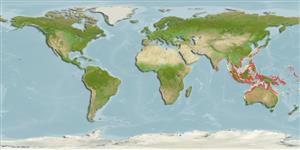Acrochordus granulatus (Schneider, 1799)
File snake| Native range | All suitable habitat | Point map | Year 2050 |

|
| This map was computer-generated and has not yet been reviewed. |
| Acrochordus granulatus AquaMaps Data sources: GBIF OBIS |
Upload your photos
Google image |
No photo available for this species.No drawings available for Acrochordidae.
Google image |
No photo available for this species.
Classification / Names Common names | Synonyms | CoL | ITIS | WoRMS
Not assigned | Squamata | Acrochordidae
Environment: milieu / climate zone / depth range / distribution range Ecology
Benthopelagic; brackish; depth range 4 - 20 m (Ref. 2413). Tropical
Distribution Countries | FAO areas | Ecosystems | Occurrences | Introductions
Indo-West Pacific.
Length at first maturity / Size / Weight / Age
Maturity: Lm 58.0 range ? - ? cm Max length : 81.0 cm SVL male/unsexed; (Ref. 2413)
Short description Morphology
This species has small scales with tubercle-like keels, and a stout and compressed body. Females grow to a larger size than males.
Length based on occurrence record; to be replaced with a better reference. Nocturnal. Feeds on gobies and occasionally on marine crustaceans (Ref. 2413). Usually found in inshore waters, estuaries, and tidal rivers (Ref. 78651).
Life cycle and mating behavior Maturity | Reproduction | Spawning | Eggs | Fecundity | Larvae
Breeding season begins in July (end of monsoon season) to December in Phangnga Bay. Clutch size averaged 5.18 -/+ 0.37 individuals and increased with maternal body size.
Main reference
References | Coordinator | Collaborators
Wangkulangkul, S., K. Thirakhupt and H.K. Voris. 2005. (Ref. 2413)
IUCN Red List Status (Ref. 130435)
Least Concern (LC) ; Date assessed: 18 October 2020
CITES status (Ref. 108899)
Not Evaluated
CMS (Ref. 116361)
Not Evaluated
Threat to humans
Human uses
Fisheries: of no interest
| FishSource |
Tools
More information
Internet sources
BHL | BOLD Systems | CISTI | DiscoverLife | FAO(Publication : search) | Fishipedia | GenBank (genome, nucleotide) | GloBI | Gomexsi | Google Books | Google Scholar | Google | PubMed | Tree of Life | Wikipedia (Go, Search) | Zoological Record
Estimates based on models
Preferred temperature
(Ref. 115969): 25.2 - 29.3, mean 28.7 (based on 2280 cells).
Resilience
(Ref. 69278):
High, minimum population doubling time less than 15 months (K=0.83-1.39).
Price category
(Ref. 80766):
Unknown.


